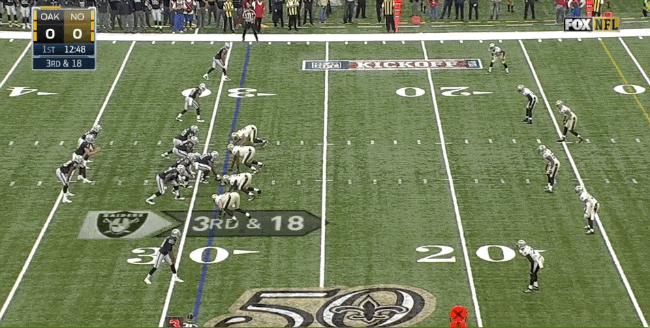Why can Oakland Raiders wide receiver Amari Cooper no longer hang onto the ball?
Don’t get me wrong, Cooper is an immensely talented young receiver, on his way to becoming one of the best in the game, but the question is now whether he is going to do that with a small caveat attached to his career, the way Jets WR Brandon Marshall has—sure he’s a great receiver, but he drops a lot of passes.
The strange thing with Cooper is that the trait seems to have developed in the NFL. He dropped eight passes his final season at Alabama, and while four of them came in one game, his overall drop rate for the season was not bad at all, because he was thrown at 174 times, the most in the nation by a clear 11 targets.

His drop rate of 6.1 percent actually ranked 26th in the FBS for the 2014 season, ahead of players like Kevin White, Nelson Agholor, Stefon Diggs, and Tyler Lockett.
Cooper hit the ground running in the NFL, catching 20 passes for 290 yards in the first three games of his rookie season—but each of those games also featured a drop. In fact, Cooper recorded two more multiple-drop games (six) than he did games without a single drop (four) over his rookie season, and ended the year with a pretty ridiculous 18. Not all of these were easy receptions, but every single one hit his hands, and he led the league by three drops. There were only nine other players to drop double-digit passes, and this time, the volume of targets sent his way doesn’t make the picture look any better. If anything, it looks worse.
Cooper dropped 20.7 percent of the catchable passes thrown his way during the 2015 season, a figure only Brandon LaFell (with the Patriots last season) was worse than. If you include the playoffs, he actually drops below LaFell for the title of worst hands in the league among wide receivers. Cooper was significantly worse than even Carolina's Ted Ginn in that regard, a guy on whom the consensus is that he “would be a pretty good receiver if he didn’t drop so many passes.”
It reached a point last season where an observer could practically see it playing on Cooper's mind as the ball arrived. Drops can affect receivers like quicksand—once a player drops a few passes, the more he starts fighting not to drop the ball, and the more it happens. Catching needs to be an instinctive thing that a receiver doesn't interfere with by bringing conscious thought into the equation, and when they do, things can go south in a hurry.
The hope was that an offseason would serve as a reset button for Cooper, get the thought of drops out of his head, and allow him to go back to being an instinctive playmaker. In Week 1 against New Orleans, however, more of the same problem prevailed. Cooper dropped one pass, and had another play where he caught a simple smoke route and then flung the ball clean out of bounds, like he’d simply forgotten he needed to grip it.

If you count that as a drop rather than a fumble, then Cooper is right back to his 2015-self in terms of drops—actually, far worse than his drop rate from a year ago. Whatever you want to classify it as, we can at least agree that it’s not good ball control.
2014 was the first season PFF began grading college games, so it’s possible that Cooper's drop rate that year was the outlier, rather than the baseline for the Alabama product. Anecdotally, I have had Alabama fans tell me he committed far more drops the season before than he did in 2014, but there are no numbers in the PFF database to back that up. Cooper's catch rate was lower in 2013 than it was in 2014, but that doesn’t necessarily mean that the gap is made up by dropped passes.
As the 2016 season unfolds, Cooper’s development and ceiling hinges on whether this is an inherent trait in his game, or a poor rut he is currently stuck in. He can still become an excellent receiver even plagued by drops—Brandon Marshall has six Pro Bowls to his name, a first– and second-team All-Pro place, led the league in touchdowns in 2015, and led the league in PFF grade in 2013—but there will always be the frustrating question of how much better he could be if he wasn’t dropping a dozen passes per season.
Cardinals WR Larry Fitzgerald has recorded as many drops in the past six seasons (including Week 1 of 2016) as Cooper managed as a rookie. In fact, over the past decade, Fitzgerald has averaged just 3.4 drops per season. If the drops Cooper had as a rookie matched his average in terms of yardage, he left another 218 yards on the table compared to Fitzgerald—a figure which would have leapt him above the veteran Arizona receiver and six other players in receiving yardage.
We have at least seen that Cooper can go an entire season with a pretty good drop rate; he was targeted 50 more times in his final season at Alabama than he was in his rookie year in Oakland, but had 10 fewer dropped passes. Maybe that season has been the outlier in his career, but the ability is at least there for his drops to be minimized. Which way it goes in future will go a long way to determining just how good Cooper can become, because right now, it’s the only significant flaw in his game.



 © 2025 PFF - all rights reserved.
© 2025 PFF - all rights reserved.